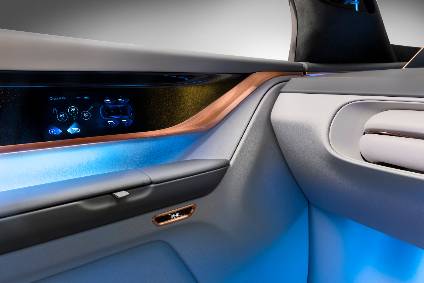 |
|
Yanfeng Automotive Interior’s smart interior surfaces blend in with the decor of its floor consoles, instrument and door panels. |
Smart surface embedded displays are reckoned to be the Next Big Thing in terms of car interior trends. Secondary capacitive touch surfaces using hard-coated films can also be applied to certain parts of the interior. Morphing buttons and tactile controls are being heralded as a further way to create a better and more intuitive user experience. The trend for shared mobility and the need to keep interior surfaces clean, especially during a pandemic, certainly makes the task of sterilising such areas safer and easier. And with autonomous vehicles on the horizon, the possibilities for interactive surfaces are endless. Continuing just-auto/AIC’s series of research snapshots, Matthew Beecham assesses just how smart interiors are becoming.
Interacting with the car interior
Minimalist cockpits are a clear trend in terms of car interior design. Replacing buttons and dials with a central touchscreen has become commonplace. While touchscreens offer space-saving possibilities, designers are faced with the problem of the dangers of distracting the driver. A continuing focus of R&D is therefore on more intuitive, safer and simple control options for motorists, including the integration of haptic feedback into touch-sensitive surfaces.
Smart surfaces can move the game on while reducing weight and cabin complexity. Using a variety of electronics, materials and light sources, they create greater interior design freedom and can help differentiate car brands. The following highlights some supplier innovations that caught our eye in this evolving automotive sector.
Yanfeng Technology has been pushing back the technical boundaries of smart interiors for some time. The supplier has expertise in the integration of technologies into all kinds of surfaces, whether plastic, wood and natural fibres, leather, textile or metal decorative surfaces.
Han Hendriks, Chief Technology Officer at Yanfeng Technology, told just-auto: “Next-generation A-surfaces [have] become smarter than ever and are now able to interact with vehicle passengers to display visual information, control functions, and allow for a personalised interior. As a result, surfaces which previously only had a decorative function will become touch-sensitive control surfaces in the interiors of future vehicles. Functionalities from customer-specific operating concepts can be integrated on almost all interior surfaces.”
Yanfeng’s Experience in Motion 2020 (XiM20) concept vehicle embodies its Smart Cabin that features functional surfaces, health and wellness features, and connectivity seamlessly integrated in all interior systems including seating. “Our XiM20 offers information, displays, lighting, and interior ambience and provides flexibility and comfort for the autonomous rideshare passengers of tomorrow,” added Hendriks. “Since all solutions are customisable and enable new forms of interaction, it brings surprise and delight in the mobility space.”
Grupo Antolin is also engaged in the smart surfaces arena. Its latest solutions form part of its Smart Integrator strategy designed to address the CASE (connected, autonomous, shared and electric) car revolution in the auto industry. As part of its integrated interiors range, the Spanish supplier has developed a lighting system for decorative parts with integrated functions and capacitive switches converted into a smart surface. It comes in sustainable natural materials such as stone which aim to transform the user experience.
Canatu, a developer and manufacturer of transparent conductive films and touch sensors, has co-developed a steering wheel concept. It is designed to improve safety by reducing driver distraction with intuitive controls adapted from smartphone user experiences. The Origo Steering Wheel concept aims to improve the way in which a driver accesses information, and controls non-driving functions, using thumb controls. The concept replaces multiple mechanical controls in different locations with 3D touch sensors that are integrated in the steering wheel. Canatu provides its transparent Carbon NanoBud (CNB) film based touch sensors that are integrated into the steering wheel. CNB sensors can be formed and moulded into any shape providing design-freedom. Other partners contributing to the concept include TactoTek which applied its Injection Molded Structural Electronics technology to design and produce smart surfaces that include circuitry, touch controls and illumination in 3D injection moulded designs.
In a separate development, TactoTek partnered with Fischer Automotive to develop a smart surface technology demonstrator. It features sensor surfaces for operating command input that are illuminated with LEDs moulded into the plastic that forms the engineered structure of the part. Illumination is used for styling, guiding interactions and communicating vehicle status information to the driver.
German foil specialist Leonhard Kurz has developed a human-machine interface (HMI) concept for an automotive display panel. A special feature of the HMI instrument panel is its almost one metre wide single-image design produced by means of the IMD (In-Mould decoration) process. The panel presents a detail-rich surface design into which touch and light functions have been embedded. The central operating element of the instrument panel is a touchscreen with multi-touch function and supplementary touch buttons. The panel also contains touch controls for operating ambient lighting. These touch controls are only visible when the panel is backlit; when the illumination is deactivated, the surface appears solid and opaque.
Smart surfaces come to life
It’s clear that this aspect of interior design offers some exciting possibilities. Transforming passive parts into an interactive display also aligns with the auto industry’s transition to driverless cars. Autonomous vehicles will doubtless heighten demand for aesthetic surfaces that can double as functional controls. In the meantime, expect to see a variety of switches, controls and displays in surprising areas of the cabin, hidden behind materials, and surfacing only when the need arises to provide a better user experience and meet the digital needs of the driver.




